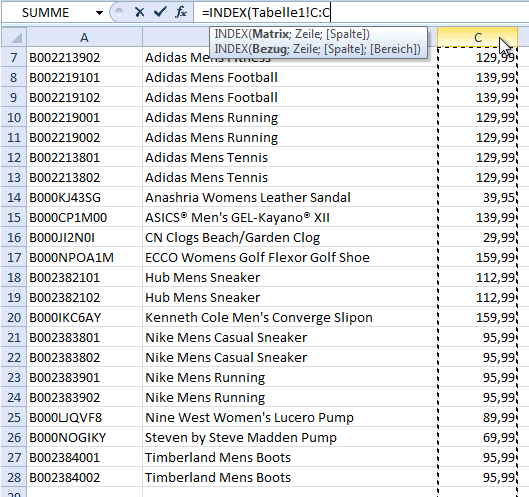How to Use INDEX-MATCH for Flexible Data Lookups
Learn how to use INDEX and MATCH functions together for more powerful and flexible data lookups than VLOOKUP.
When to Use INDEX-MATCH
Use INDEX-MATCH instead of VLOOKUP when:
- The lookup column is not the first column
- You can't sort your source data
- You need to look up values to the left
- You want more flexibility in your formulas
Why INDEX-MATCH is Better Than VLOOKUP
VLOOKUP limitations:
- Requires the search column to be first
- Must be sorted by search column
- Can only look to the right
- Harder to maintain when columns change
INDEX-MATCH advantages:
- Search any column in any position
- No sorting required
- Can look in any direction
- More flexible and maintainable
Understanding the Functions
INDEX Function
Returns a value from a specific position in a column or range.
=INDEX(matrix; row; [column])

MATCH Function
Finds the position of a value in a range.
=MATCH(search_criterion; matrix; match_type)

Combined Formula
=INDEX(column_to_return; MATCH(search_value; column_to_search; 0))
In plain language:
- Find the position of search_value in column_to_search
- Return the value at that position from column_to_return
Step-by-Step: Assign Prices from Supplier List
This example shows the same task as the VLOOKUP tutorial, but with more flexibility.
Step 1: Open Supplier List and Load Products
- Open your supplier's Excel file
- Switch to cobby
- Click "Load products"
Step 2: Start the INDEX Formula
Click on the Price column and enter in the formula bar:
=INDEX(

Step 3: Select the Return Column
Switch to the supplier list and click the column header containing the prices:
=INDEX(SupplierSheet!C:C;

Step 4: Add MATCH Function
Continue the formula with MATCH and select your search criterion (e.g., Model):
=INDEX(SupplierSheet!C:C;MATCH([@Model];

Step 5: Select the Search Column
Switch to the supplier list and select the Model column:
=INDEX(SupplierSheet!C:C;MATCH([@Model];SupplierSheet!B:B;

Step 6: Set Match Type to Exact
Add 0 for exact match and close the parentheses:
=INDEX(SupplierSheet!C:C;MATCH([@Model];SupplierSheet!B:B;0))

Step 7: Apply to All Products
Double-click the small square at the bottom-right of the cell to apply the formula to the entire column.

Common Use Cases
Look Up by EAN
=INDEX(PriceColumn;MATCH([@EAN];EANColumn;0))
Match Mixed Data Types
Use with VALUE or TEXT functions:
=INDEX(NameColumn;MATCH(VALUE([@[SKU]]);SupplierSKU;0))
Multiple Lookups
' Get price
=INDEX(SupplierData!C:C;MATCH([@SKU];SupplierData!A:A;0))
' Get stock
=INDEX(SupplierData!D:D;MATCH([@SKU];SupplierData!A:A;0))
' Get description
=INDEX(SupplierData!E:E;MATCH([@SKU];SupplierData!A:A;0))
Formula Breakdown
Let's understand each part:
=INDEX(column_from_which_we_want_to_return_a_value;
MATCH(current_table[search_criterion];
linked_table[search_criterion];
0))
Parameters:
- First INDEX parameter: The column containing the data you want
- First MATCH parameter: The value you're searching for (from your cobby table)
- Second MATCH parameter: The column to search in (from supplier table)
- Third MATCH parameter: 0 = exact match
Tips
- No sorting required: Unlike VLOOKUP, your data doesn't need to be sorted
- Use whole columns: Reference entire columns (C:C) for simplicity
- 0 means exact match: Always use 0 for the match_type parameter
- Column order doesn't matter: Return and search columns can be in any order
- More maintainable: If columns are added/removed, formula still works
Advanced Techniques
Handle Missing Matches
=IFERROR(INDEX(PriceColumn;MATCH([@SKU];SupplierSKU;0));"Not Found")
Two-Way Lookup (Like VLOOKUP and HLOOKUP Combined)
=INDEX(DataRange;MATCH(RowValue;RowRange;0);MATCH(ColValue;ColRange;0))
Approximate Match (Sorted Data)
=INDEX(PriceColumn;MATCH([@Quantity];QuantityBreaks;1))
Use 1 instead of 0 for the largest value less than or equal to search value.
Troubleshooting
Getting #N/A error?
- The search value wasn't found in the search column
- Check for exact match (extra spaces, different formats)
- Use TRIM to clean spaces:
MATCH(TRIM([@SKU]);...)
Getting #REF! error?
- The matched position is outside the INDEX range
- Ensure both ranges have the same number of rows
Getting #VALUE! error?
- Data type mismatch (text vs numbers)
- Use VALUE or TEXT to convert formats
Formula not calculating?
- Set cell format to "Standard" instead of "Text"
- Right-click > Format Cells > Standard
Performance Considerations
Speed:
- INDEX-MATCH is faster than VLOOKUP on large datasets
- Both functions recalculate when data changes
- Consider using absolute references to reduce calculations
Best practices:
- Reference only the columns you need, not entire sheets
- Use named ranges for clarity
- Combine with IFERROR for robust formulas
INDEX-MATCH vs VLOOKUP
| Feature | VLOOKUP | INDEX-MATCH |
|---|---|---|
| Lookup direction | Right only | Any direction |
| Column position | Must be first | Any position |
| Sorting required | Yes | No |
| Speed | Slower | Faster |
| Flexibility | Limited | High |
| Maintenance | Harder | Easier |
Related Functions
- XLOOKUP: Modern Excel lookup (not available in older versions)